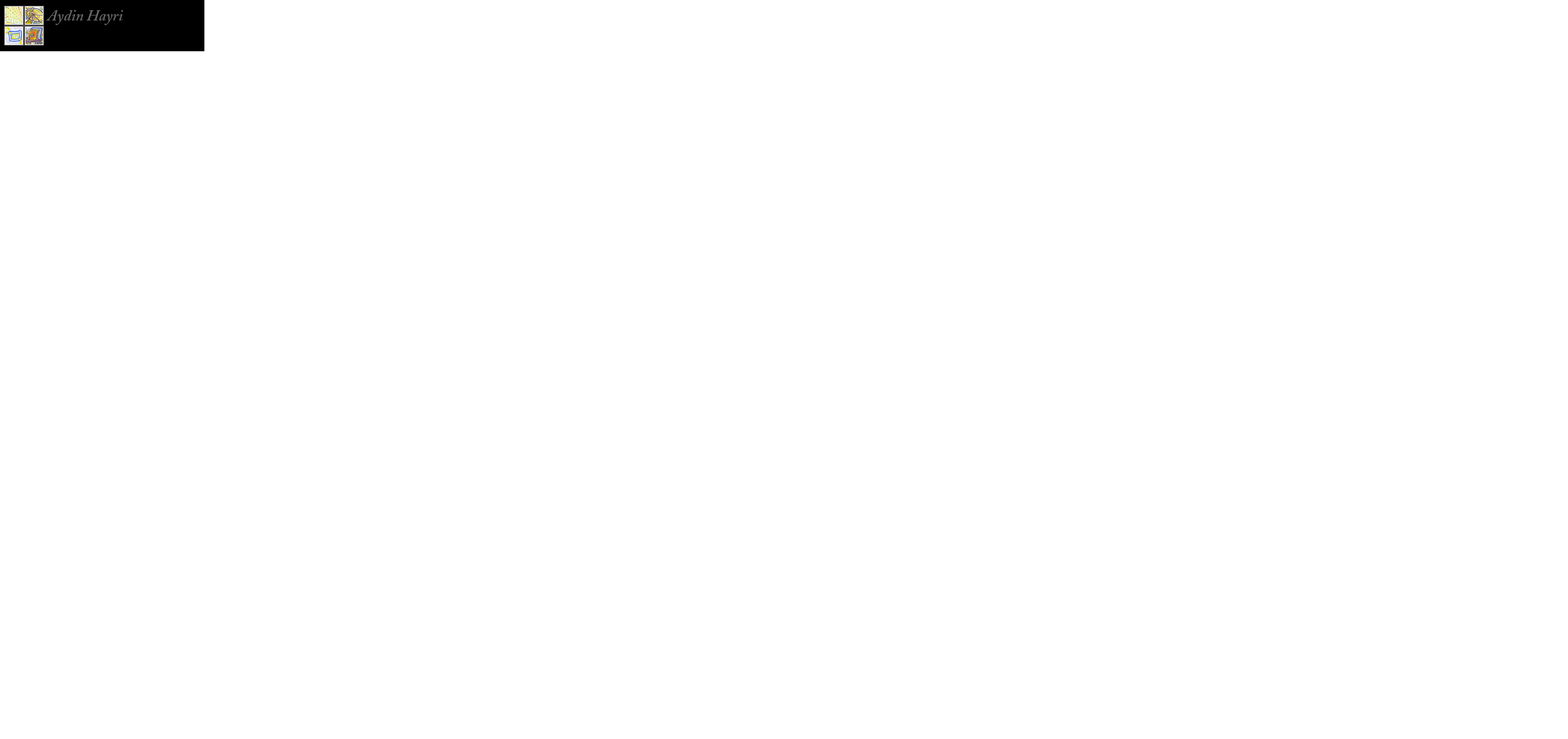Desert Rose
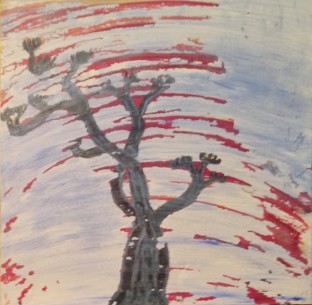 Desert Rose, Aydin Hayri, 2013. Acrylic on laminated particle board. 12” × 12
In the winter of 2013, our family took a driving trip of Morocco. One image stood out from that trip — the desert rose — I do not know whether it is the official or correct name for this plant, but here is how it looks, an ungainly, bulbous stem and sharply narrowing stems and leaves, with unexpectedly beautiful flowers.
What may come across as an ugly duckling is a streamlined plant, surviving in an extreme environment. Due to difficulty of applying paint on a laminated particle board, created this stripped paint look of a sandstorm, showing the desert rose withstanding a sustained attack with grace, presumably to blossom on another day. I think I will keep visiting the desert rose theme, trying different depictions of this long serving, diligent plant.
$120.-
Desert Rose, Aydin Hayri, 2013. Acrylic on laminated particle board. 12” × 12
In the winter of 2013, our family took a driving trip of Morocco. One image stood out from that trip — the desert rose — I do not know whether it is the official or correct name for this plant, but here is how it looks, an ungainly, bulbous stem and sharply narrowing stems and leaves, with unexpectedly beautiful flowers.
What may come across as an ugly duckling is a streamlined plant, surviving in an extreme environment. Due to difficulty of applying paint on a laminated particle board, created this stripped paint look of a sandstorm, showing the desert rose withstanding a sustained attack with grace, presumably to blossom on another day. I think I will keep visiting the desert rose theme, trying different depictions of this long serving, diligent plant.
$120.-Stuck
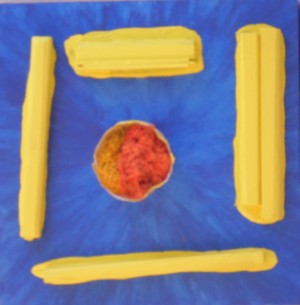 Stuck, Aydin Hayri, 2013. Acrylic paint, wood, wire mesh, natural moss on wooden board, 8″ x 8″.
Here is another variation on the theme of our desire to protect our valuables, sometimes at the cost of strangling our creativity or locking up our potential. Here the pile of moss in the middle represents our creative potential, protected by a wire mesh fence, against the intrusions of the ocean. The four barriers appear to be run over. The protection also becomes a restriction. We are protected and stuck at the same time. Hard to tell, in this work of art, as well as in life, when we are stuck versus just being well protected.
$100.-
Stuck, Aydin Hayri, 2013. Acrylic paint, wood, wire mesh, natural moss on wooden board, 8″ x 8″.
Here is another variation on the theme of our desire to protect our valuables, sometimes at the cost of strangling our creativity or locking up our potential. Here the pile of moss in the middle represents our creative potential, protected by a wire mesh fence, against the intrusions of the ocean. The four barriers appear to be run over. The protection also becomes a restriction. We are protected and stuck at the same time. Hard to tell, in this work of art, as well as in life, when we are stuck versus just being well protected.
$100.-Misplaced Meaning
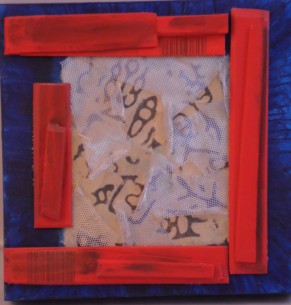 Misplaced Meaning, Aydin Hayri, 2013. Acrylic paint, wood, paper, wire mesh on wood board, 8″ x8″.
This is a study of our efforts to preserve things we find valuable, yet often failing in that effort. Here rotting wood barriers are erected and a wire mesh is stretched over to protect the layers of gibberish writings against the intruding blue (ocean?). Whatever original meaning may have been out there has been covered over and repaired with patches and the efforts to neatly hold it together with a wire mesh cover have apparently failed. I retained the barcodes on the pieces of wood to emphasize the systematic efforts we (as human communities) go through to protect something we believe or hope to be valuable even if the “thing” may have lost its meaning.
$100.-
Misplaced Meaning, Aydin Hayri, 2013. Acrylic paint, wood, paper, wire mesh on wood board, 8″ x8″.
This is a study of our efforts to preserve things we find valuable, yet often failing in that effort. Here rotting wood barriers are erected and a wire mesh is stretched over to protect the layers of gibberish writings against the intruding blue (ocean?). Whatever original meaning may have been out there has been covered over and repaired with patches and the efforts to neatly hold it together with a wire mesh cover have apparently failed. I retained the barcodes on the pieces of wood to emphasize the systematic efforts we (as human communities) go through to protect something we believe or hope to be valuable even if the “thing” may have lost its meaning.
$100.-Bitter, Sweet Freedom
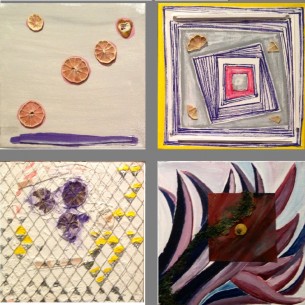 Bitter, Sweet Freedom, Aydin Hayri, 2014. Acrylic paint, wire mesh, lemon slices and other found objects, 24” x 24”
In this four panel series I continue my exploration of our desire for freedom versus preservation of our valuables (represented here with dried lemon slices). However we choose to protect them, under lock, or through camouflage, or by putting boxes around them, there is an irrepressible desire to fly away, but such flight is not without its own hazards, as the mutilated slices on the top left panel depicts. Ways we try to protect ourselves or our valuables is immensely diverse and stupefying, but somewhat futile.
The exhibition shows only the three of the four panels.
$100 per panel
Bitter, Sweet Freedom, Aydin Hayri, 2014. Acrylic paint, wire mesh, lemon slices and other found objects, 24” x 24”
In this four panel series I continue my exploration of our desire for freedom versus preservation of our valuables (represented here with dried lemon slices). However we choose to protect them, under lock, or through camouflage, or by putting boxes around them, there is an irrepressible desire to fly away, but such flight is not without its own hazards, as the mutilated slices on the top left panel depicts. Ways we try to protect ourselves or our valuables is immensely diverse and stupefying, but somewhat futile.
The exhibition shows only the three of the four panels.
$100 per panelLost Knowledge
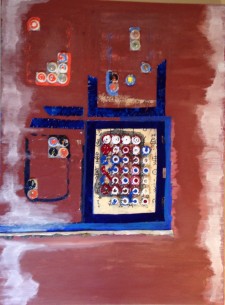 Lost Knowledge, Aydin Hayri, 2013. Acrylic paint, natural pigments, found objects on canvas, 40” × 30
Today’s information overload makes knowledge harder and harder to retain. This painting started my exploration of lost valuables that we try hard to protect. In this case, knowledge, appears to be lost, washed away in the deluge of information. Knowledge is represented by the “letters” visible in the background. These are not from any particular alphabet, but random figures printed on a gift wrap paper. They represent the literary knowledge codified into the structured cells. The cells show that chaotic fight of different colors — we see one color engulfing the other.
There is barrier at the bottom that was meant to protect them, but, apparently, has not been effective. The barrier is made by natural stones, held in place by paint. I use this motif of a barrier in different paintings. Here there is a flap over the barrier made from an extra piece of canvas. The original inspiration for this painting was a photograph of a window on an earthen stucco wall — I cannot find the photograph or the reference to it, but it was a magazine published by GW Hospital doctors showing different works of art by the doctors.
$900.-
Lost Knowledge, Aydin Hayri, 2013. Acrylic paint, natural pigments, found objects on canvas, 40” × 30
Today’s information overload makes knowledge harder and harder to retain. This painting started my exploration of lost valuables that we try hard to protect. In this case, knowledge, appears to be lost, washed away in the deluge of information. Knowledge is represented by the “letters” visible in the background. These are not from any particular alphabet, but random figures printed on a gift wrap paper. They represent the literary knowledge codified into the structured cells. The cells show that chaotic fight of different colors — we see one color engulfing the other.
There is barrier at the bottom that was meant to protect them, but, apparently, has not been effective. The barrier is made by natural stones, held in place by paint. I use this motif of a barrier in different paintings. Here there is a flap over the barrier made from an extra piece of canvas. The original inspiration for this painting was a photograph of a window on an earthen stucco wall — I cannot find the photograph or the reference to it, but it was a magazine published by GW Hospital doctors showing different works of art by the doctors.
$900.-Pop-Up Island
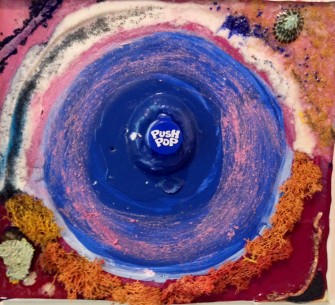 Aydin Hayri, 2014. Acrylic, seashells, moss, foam, plastic candy cap on canvas, 10″ x 10″
As you may know, most islands in the South Pacific, and elsewhere were pop-up islands. Here is another one!
This one is an inverted image, island being a clean, blue disk in a sea of darker and cluttered sea, with an inviting beach on its north side. The Push-Pop cap in the middle has been the key element around which I built this fictional island. One can read more into it: One view may be that the Pop-Up Island may be an effort by the earth to restore the tranquility of the seas. The opposite view may be that the Pop-Up Island is a theme park that just popped up in the cluttered waters around it.
My thinking is that visual arts should provide an aesthetically attractive and remarkable vessel to be filled with contemplations and thoughts of its viewers.
$200.-
Aydin Hayri, 2014. Acrylic, seashells, moss, foam, plastic candy cap on canvas, 10″ x 10″
As you may know, most islands in the South Pacific, and elsewhere were pop-up islands. Here is another one!
This one is an inverted image, island being a clean, blue disk in a sea of darker and cluttered sea, with an inviting beach on its north side. The Push-Pop cap in the middle has been the key element around which I built this fictional island. One can read more into it: One view may be that the Pop-Up Island may be an effort by the earth to restore the tranquility of the seas. The opposite view may be that the Pop-Up Island is a theme park that just popped up in the cluttered waters around it.
My thinking is that visual arts should provide an aesthetically attractive and remarkable vessel to be filled with contemplations and thoughts of its viewers.
$200.-Which Circular Jetty, My Love?
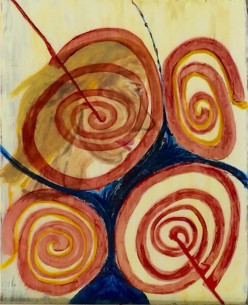 Which Circular Jetty, My Love? Aydin Hayri, 2013. Acrylic paint on plexiglass, 24″ x 18″.
Continuing on the theme of circular jetties, here am I dreaming of spiral jetties. This is the quest of a lover seeking love. His or her beloved is behind one of the circular jetties. This WOA combines my admiration of the Spiral Jetty with my fondness for using found objects. This piece of Plexiglas was a scrap I found in a dumpster.
$200.-
Which Circular Jetty, My Love? Aydin Hayri, 2013. Acrylic paint on plexiglass, 24″ x 18″.
Continuing on the theme of circular jetties, here am I dreaming of spiral jetties. This is the quest of a lover seeking love. His or her beloved is behind one of the circular jetties. This WOA combines my admiration of the Spiral Jetty with my fondness for using found objects. This piece of Plexiglas was a scrap I found in a dumpster.
$200.-Orgy of Spiral Jetties
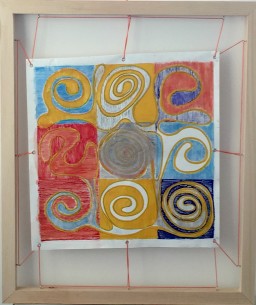 Orgy of Spiral Jetties, Aydin Hayri, 2015. Acrylic, charcoal, varnish, and steel mesh on canvas, 24” × 24”
The Spiral Jetty, Robert Smithson’s seminal work, an earthwork sculpture, etched on the surface of the earth. Does not this small painting look pathetic in comparison to the grand scale of the real thing? Well, I intend this to be applied on a retaining wall next to our house. Then it may compare a bit better, in physical dimension only, to the real thing.
The orgy shows nine spiral jetties of in different colors and shapes connected around one of them. The Spiral Jetty is an awe inspiring work that may be assigned spiritual meanings, whether meant by the artist of not. Spirals have also popped up as symbols in wide swath of cultures around the world, as well as appearing many natural phenomena, like the storms. This painting shows the spiritual unity and vibrancy of our world.
$450.-
Orgy of Spiral Jetties, Aydin Hayri, 2015. Acrylic, charcoal, varnish, and steel mesh on canvas, 24” × 24”
The Spiral Jetty, Robert Smithson’s seminal work, an earthwork sculpture, etched on the surface of the earth. Does not this small painting look pathetic in comparison to the grand scale of the real thing? Well, I intend this to be applied on a retaining wall next to our house. Then it may compare a bit better, in physical dimension only, to the real thing.
The orgy shows nine spiral jetties of in different colors and shapes connected around one of them. The Spiral Jetty is an awe inspiring work that may be assigned spiritual meanings, whether meant by the artist of not. Spirals have also popped up as symbols in wide swath of cultures around the world, as well as appearing many natural phenomena, like the storms. This painting shows the spiritual unity and vibrancy of our world.
$450.- Floating Underneath my Shirt
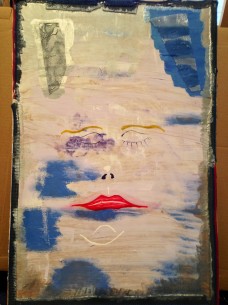 Floating Underneath my Shirt, Aydin Hayri, 2014. Natural pigments, acrylic, fabric, wire mesh on plywood panel, 15” x 24
I started with a scrap piece of plywood and began experimenting with some of the natural pigments I had. I got this “floating” feeling of the pinkish white, with blue blotches. For this piece, the main found object was an old t-shirt. I used the thicker and elastic fabric of the collar for the edges of this work. Hard to see from the photograph, but going all around the edges of the panel are these strips cut from the old t-shirt, glued and stapled to the plywood panel. But the glue did not work very well with the fabric. To seal it, I decided to use grey acrylic paint, matching the grey-blue colors of the old t-shirt. Introduction of grey to this otherwise light, fleeting scenery changed this tableau from one of joyful harmony to one of conflict — a war of the blue against the grey — favorite military colors.
One of my earlier art house movie experiences that have stayed with me is Excalibur by director John Boorman. In this piece, do not look for the sword! Here you will only see the guardian angel of Excalibur disappearing in the waters after reclaiming it, as the blue-grey conflict dissipates. A few months ago, a friend pointed out the similarities between this painting and the cover of an edition of Great Gatsby. Anyway, Excalibur or Great Gatsby, simply enjoy.
$400.-
Floating Underneath my Shirt, Aydin Hayri, 2014. Natural pigments, acrylic, fabric, wire mesh on plywood panel, 15” x 24
I started with a scrap piece of plywood and began experimenting with some of the natural pigments I had. I got this “floating” feeling of the pinkish white, with blue blotches. For this piece, the main found object was an old t-shirt. I used the thicker and elastic fabric of the collar for the edges of this work. Hard to see from the photograph, but going all around the edges of the panel are these strips cut from the old t-shirt, glued and stapled to the plywood panel. But the glue did not work very well with the fabric. To seal it, I decided to use grey acrylic paint, matching the grey-blue colors of the old t-shirt. Introduction of grey to this otherwise light, fleeting scenery changed this tableau from one of joyful harmony to one of conflict — a war of the blue against the grey — favorite military colors.
One of my earlier art house movie experiences that have stayed with me is Excalibur by director John Boorman. In this piece, do not look for the sword! Here you will only see the guardian angel of Excalibur disappearing in the waters after reclaiming it, as the blue-grey conflict dissipates. A few months ago, a friend pointed out the similarities between this painting and the cover of an edition of Great Gatsby. Anyway, Excalibur or Great Gatsby, simply enjoy.
$400.-
Mythistorema – What Seek our Souls?
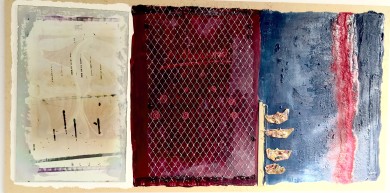 Mythistorema – What Seek our Souls?, Aydin Hayri, 2014. Acrylic, glass pane, paper, wire mesh on plywood, 30” × 55
This piece was inspired by the 8th section of Yorgo Seferis’s epic poem Mythistorema. Below is the English translation of that section of the poem by Edmund Keeley and Philip Sherrard:
What are they after, our souls, traveling on the decks of decayed ships
crowded in with sallow women and crying babies
unable to forget themselves either with the flying fish
or with the stars that the masts point our at their tips;
grated by gramophone records, committed to non-existent pilgrimages unwillingly,
murmuring broken thoughts from foreign languages.
What are they after, our souls, traveling on rotten brine-soaked timbers
from harbor to harbor?
Shifting broken stones, breathing in the pines’ coolness with greater difficulty each day,
swimming in the waters of this sea and of that sea,
without the sense of touch without men in a country that is no longer ours nor yours.
We knew that the islands were beautiful somewhere round about here where we grope,
slightly lower down or slightly higher up, a tiny space.
I have been carrying this poem’s implacable sense of melancholic quest in my soul since I left my parents’ home for boarding school at age 14. It was a bit of relief to give it a physical form.
$1,200.-
Mythistorema – What Seek our Souls?, Aydin Hayri, 2014. Acrylic, glass pane, paper, wire mesh on plywood, 30” × 55
This piece was inspired by the 8th section of Yorgo Seferis’s epic poem Mythistorema. Below is the English translation of that section of the poem by Edmund Keeley and Philip Sherrard:
What are they after, our souls, traveling on the decks of decayed ships
crowded in with sallow women and crying babies
unable to forget themselves either with the flying fish
or with the stars that the masts point our at their tips;
grated by gramophone records, committed to non-existent pilgrimages unwillingly,
murmuring broken thoughts from foreign languages.
What are they after, our souls, traveling on rotten brine-soaked timbers
from harbor to harbor?
Shifting broken stones, breathing in the pines’ coolness with greater difficulty each day,
swimming in the waters of this sea and of that sea,
without the sense of touch without men in a country that is no longer ours nor yours.
We knew that the islands were beautiful somewhere round about here where we grope,
slightly lower down or slightly higher up, a tiny space.
I have been carrying this poem’s implacable sense of melancholic quest in my soul since I left my parents’ home for boarding school at age 14. It was a bit of relief to give it a physical form.
$1,200.-Flag as a Self-Portrait — Layer it on!
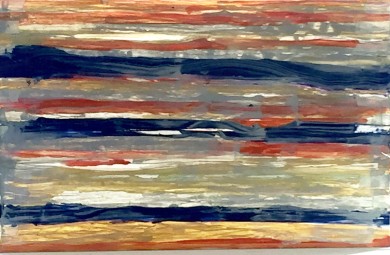 Flag as a Self-Portrait – Layer it on! Aydin Hayri, 2015. Acrylic, string, steel wire, and tape on glass, 8” × 16”
Layers. Put on layers to keep warm. Put on layers of paint to cover the old, ugly, worn out. Put on layers beautify potholed, crumbling road, or skin.
Layering assigns meaning to ourselves, projecting our presumed identity to the world.
Layering assigns meaning to our lives, covering what needs to be forgotten so as to move forward.
There is nothing original bout layering. Many visual artists have done it before. In this work I pay homage to Gerhard Richter whose 2002 MOMA exhibit rekindled, rejuvenated my interest in art.
This is also a self-portrait of sorts as I continue to build my “self” by layering on different strands. Some layers are meant to cover the old, like the blue, reddish, and yellowish paint stripes, others are just to provide an accent, like the wire and the string. Taping in the back represents the improvised nature of my layering and making of my “self.”
$500.-
Flag as a Self-Portrait – Layer it on! Aydin Hayri, 2015. Acrylic, string, steel wire, and tape on glass, 8” × 16”
Layers. Put on layers to keep warm. Put on layers of paint to cover the old, ugly, worn out. Put on layers beautify potholed, crumbling road, or skin.
Layering assigns meaning to ourselves, projecting our presumed identity to the world.
Layering assigns meaning to our lives, covering what needs to be forgotten so as to move forward.
There is nothing original bout layering. Many visual artists have done it before. In this work I pay homage to Gerhard Richter whose 2002 MOMA exhibit rekindled, rejuvenated my interest in art.
This is also a self-portrait of sorts as I continue to build my “self” by layering on different strands. Some layers are meant to cover the old, like the blue, reddish, and yellowish paint stripes, others are just to provide an accent, like the wire and the string. Taping in the back represents the improvised nature of my layering and making of my “self.”
$500.-Aydin’s Art – Video Presentation: Aerial View of Fields in Winter 2014
In the video below, I discuss my latest work of art, Aerial View of Fields in Winter, December 2014:
Click below for accessing the same video on YouTube: http://youtu.be/5IXna58vKmw
